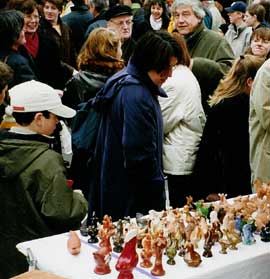 |
: feasts and fears |
||||||||
| The regional literature abounds in quotations of these festivals or pilgrimage where were sold clay whistles. These festivals often then become the "evidence of old agrarian rites". With the risk to kill the poetry of this interpretation, we are forced to note that the explanation is often simpler. The clay whistle is a toy and it is normal to see it on sale at the time of the festivals and fairs attracting significant crowds. Who would see in the salesmen of Asian toys or balloons during our current fairs, the heirs of priests and druides! A more serious study about some of our fairs of whistles in the 20th century makes it possible to be more prosaic.
In Luxembourg, the day of the whistles (Emaïshen) when the city is invaded by the merchants of clay whistles for the Easter Monday corresponds to the old pottery fair where, after the winter, the inhabitants came to restock their pottery. It was of course the occasion to buy the whistles for the children.
|
 Celebrates of Emaïshen in Luxembourg. 2000 Stand of whistles from the whole world |
||||||||
| It is true that a tradition is like a stacking of layers. Each period adds its uses and its symbolic system. Many feasts, fairs and pilgrimages of the modern time were superimposed on old pre-Christian traditions. The use of the clay whistle during some of these feasts is undoubtedly probable without it would be possible to generalize this assertion. All the works about the clay whistles largely develops the clay whistle symbolism of the revival. Being based on the association "cuckoo" (name given to the two tones globular whistles) and spring, the whistle would thus be used to celebrate the revival of nature. However, the majority of the models of old clay whistles are water whistles and the names of "cuckoos" and "nightingales" date only from the 19th century. The days of the festivals of the whistles are distributed all over the year without one could note a more significant frequency at the Easter period. It is thus not in the worship of spring that one should seek the primitive use of the clay whistle but more probably in the funeral rites.
Only one date of use of the clay whistles during the feasts is common to many countries of Europe. It is Christmas time.
One can more easily connect the use of these nightingales to another tradition which existed in the Alsatian region of Sundgau. During Christmas Eve, the children went from house to house in the village to ask for a corn ear taken from the "sheaf of happiness" (last sheaf cut with prayers at the end of the harvest and preserved as lucky charms).
|
|||||||||
| The best documented tradition (since 1811) took place in the north of Russia in the area of Viatka (current Kirov and old Khlynov). The clay figurines of the neighboring village of Dymkovo are known today in the whole world. The whistles manufactured in this center are always associated with the "festival of the whistles" or "dance of the whistles" which was held on the fourth Saturday after Easter. The adults danced, sang and drank in the cemetery while the children blew in the whistles that one had offered to them. The origin of this festival is a subject of many legends. For one of it, it would go up with the seat of the city by the troops of Novgorod. The men of the city awaited a reinforcement of allied by the southern door of the city whereas they arrived at night by north. Alarm was given by whistles and in the confusion which followed, the two allied troops killed each other. It is only after many deaths that the error was recognized and that, finally joining their forces, the enemy troops were overcome. After this victory, a mass took place to commemorate the deads instead of a mass for the victory. Each year an office anniversary was celebrated followed by a carnival of the whistles. Other oral sources make go up this festival with another battle which took place in 1418. All the Russian historians think that this tradition is more probably to go up with the old pagan rites. This is in accordance with the probable use of the whistle to celebrate the worship of deads. The water bird (frequent topic of the old Russian whistles which disappeared from the current production) indeed represents the soul of deads in many religions. In France, the "days of the whistle" are reported in several villages.
|
|||||||||